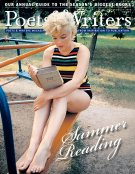As the English-speaking world's most famous playwright, William Shakespeare wields a tremendous influence over popular culture, even four centuries after his death. Aside from theatrical and film adaptations too numerous to count, one need only look at the steady stream of entertainment owing more than a tip of the hat to the bard's plots. For example, The Taming of the Shrew donated its plot structure to Cole Porter's 1948 smash hit musical Kiss Me, Kate, as well as to the 1999 teen movie Ten Things I Hate About You. West Side Story recasts Romeo and Juliet in a grittier light, and Jane Smiley could not have written her Pulitzer Prize-winning novel A Thousand Acres without several close reads of King Lear. The literary journal Borrowers and Lenders is devoted solely to the topic of Shakespeare and his work's appropriation in contemporary culture.
One would think, then, that Hamlet would be getting plenty of ink in acknowledgments pages, liner notes, movie credits, and playbills. But that hasn't been the case, especially in literary work, despite the play's juicy material, mining as it does the dark depths of filial love and revenge. (For those who need a refresher, the tragedy, set in Denmark, recounts how Prince Hamlet, after much deliberation, exacts revenge on his uncle, Claudius, who has murdered his father, the king, and married the queen.) Hamlet's narrative bones were largely left alone by literary novelists until John Updike's Gertrude and Claudius (Knopf, 2000), and more recently, British author Matt Haig's The Dead Fathers Club (Viking, 2007).
Now two new novels, published within a month of each other, bring Hamlet into sharper contemporary focus—and they could not be more different. The Story of Edgar Sawtelle by David Wroblewski, released by Ecco in June, is a sprawling, nearly six-hundred-page work of contemporary Americana that devotes the bulk of its storyline to a dynasty of purebred dogs raised by the Sawtelle family in rural Wisconsin and hotly coveted by others with mercenary designs. Lin Enger's Undiscovered Country, published this month by Little, Brown, combines the lean feel of a thriller with a moving portrait of teenage emotional angst in the Minnesota heartland.
Wroblewski's eponymous narrator remains a teenager throughout much of the novel while Enger's protagonist, college instructor Jesse Matson, views his seventeen-year-old self from the distance afforded by adulthood. Edgar Sawtelle is Wroblewski's debut, the result of an eleven-year journey from first idea to hyped publication (replete with a blurb from Stephen King). Undiscovered Country is Enger's first literary title, but certainly not his debut: In the early 1990s, he wrote a series of mystery novels with his older brother Leif, who is an acclaimed literary novelist in his own right.
Dig a bit deeper into the two novels, however, and similarities emerge. Character names stem directly from Hamlet, as the play's scheming, brother-murdering Claudius is transformed by Wroblewski and Enger into Claude and Clay, respectively. Both novelists also haunt their protagonists with the ghosts of their fathers, who in both cases urge revenge.
The use of Hamlet as a narrative template was deliberate on the part of both authors. "It was a conscious decision for sure," Wroblewski says. "It's one of my favorite plays. I'd seen the movie version of Hamlet many times in college—I was also briefly a theater major—and one afternoon when I was thinking about how to write this story idea I had in mind about dogs, my brain started to put two and two together, juxtaposing the Hamlet story with another about a remote farm near the wilderness." Enger's appropriation was more formal, based on his years teaching Hamlet to his students at Minnesota State University in Moorhead. "I loved the raw intensity of the story," he says. "Hamlet is betrayed, losing nearly everyone he is close to. I didn't want to rewrite the story exactly, but its essence had a real emotional power I was drawn to, and I wanted to investigate the play's themes in a modern setting."
Whereas Enger's homage to Hamlet is right there on the page, never more visible than when Jesse's confession of his mutinous feelings toward his uncle spurs his friend Charlie to quip, "Who do you think you are, anyway, Hamlet?" Wroblewski was thrilled when early readers of Edgar Sawtelle, not told of any references to the play, completely missed the connection until later in the narrative. "I wanted Edgar's story to be the primary one and for people to read the book on its own merits. Otherwise the book ends up being about the gimmick and that becomes the only interest." Wroblewski acknowledged that purity is virtually impossible now, but wistfully related how he wished he had read A Thousand Acres "without knowing it was retelling King Lear."
The irony is that Hamlet's reinvention at the hands of Wroblewski, Enger, and others echoes another appropriation, made centuries earlier by another writer: William Shakespeare. "When Shakespeare was in his late twenties, the play making the rounds in London is now thought of as the Ur-Hamlet," says James Shapiro, a noted Shakespeare scholar. "We don't know how much of Ur-Hamlet he would have incorporated into his own because there is no known surviving copy, but the fact that another production popped up again in 1596 while Shakespeare's acting troupe was in London makes the connection fairly likely."
Shakespeare's own literary appropriation underscores contemporary writers' attraction to Hamlet's narrative, and its universal appeal in modern times. "Hamlet is a great story, with just about the perfect plot," Shapiro says. "It's a cultural touchstone that really invites writers to take the old version and update it for contemporary audiences."
Sarah Weinman is a freelance writer in New York City. Her article about creative nonfiction anthologies appeared in the September/October 2007 issue of Poets & Writers Magazine. Her Web site is www.sarahweinman.com.






